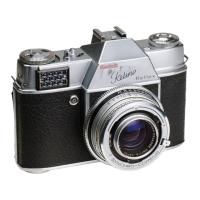4: The film cassette, its outer shell, centre spool and separate top.
5: How to fix the film to the centre spool of the cassette with a piece of adhesive tape.
6: Winding the film with the mechanical film winder to the centre spool.
7. Assembling the cassette 8. Loading the film into the camera.
Handling, Winding and Trimming the Film
When handling the actual film, particular care must be taken not to touch its emulsion (matt) side. Always
handle it and wind on to the centre spool of the cassette by holding the film by either side of its edge, preferably
between thumb and index finger. At the same time, it is of no less importance that the spot on which the loading
is done should be perfectly dry, clean and dust free.
When using bulk film in loading cassettes, the edge of the work-bench can be marked with notches or drawing-
pins to indicate various distances, let us say for 12, 24, 36 exposures of film. This considerably simplifies the
measuring of film lengths in the darkroom.
The film ends need trimming. At the beginning of the roll of film make either a straight or wedge-shaped cut for
the centre spool of the cassette and measure off the required length of film (see table, p.20). At the end of this
make the curved cut for the take-up spool. The curved cut should start between the fifth and sixth bottom
perforation -- when emulsion is towards you -- and must not go through a perforation hole.
The ready-cut film is now spooled on the centre spool of the cartridge or cassette. While winding on, hold the
film only by its edges.
Also, take care not to press too hard on the film, and don't squeeze the film-ends when drawing through the
hand. Failure to take the first precaution may result in fogging, while neglect of the latter precaution may give
rise to peculiar kinds of exposure effects known as "lightning flashes". These are due to electrical discharges,
and appear as dark, zigzag lines running from the edge of the film towards the centre of the picture.
LENGTH OF FILM REQUIRED FOR ANY NUMBER OF EXPOSURES
Number of
Exposures
Length of Film
Required
Number of
Exposures
Length of Film
Required
Number of
Exposures
Length of Film
Required
in. -- cm. In. -- cm. In. -- cm.
1 11¾ 30 14 31¾ 80 27 51 130
2 13¼ 34 15 33 84 28 52½ 133
3 15 38 16 34½ 88 29 54 137
4 16¼ 41 17 36¼ 92 30 55½ 141
5 17¾ 45 18 37¾ 96 31 57 145
6 19¼ 49 19 39¼ 100 32 58½ 148
7 20¾ 53 20 40½ 103 33 60 152
8 22 56 21 42 107 34 61½ 156
9 23¾ 60 22 43¾ 111 35 63 160
10 25¼ 64 23 45 114 36 64½ 164
11 26¾ 68 24 46½ 118 37 66 167
12 28½ 72 25 48 122 38 67½ 171
13 30 76 26 49½ 126 Including trimming
Loading Standard Cassettes
The majority of cassettes consist of a centre spool which is in a shell with top and bottom cover. The film leaves
the shell by a light-trapped slot. The centre spool can be removed from the shell by removing either top or
bottom of the cassette, according to the construction of the particular container.
Most cassettes are actually intended by their makers to be used once only, and with the film originally supplied
in it. However, provided they are reasonably robustly made, and the light-trapping velvet slot is in good
condition, these cassettes can be reloaded many times, and will give perfectly satisfactory results -- if handled
carefully.
Loading with Bulk Film or Darkroom Refills
Work in total darkness and prepare the film as described (p. 18).
1. Open the cassette.

